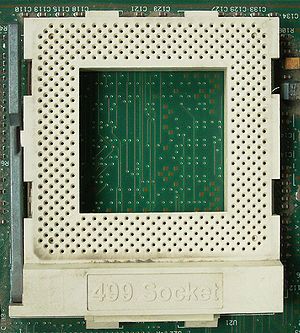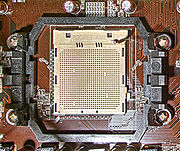- CPU Socket
-
Ein Prozessorsockel (engl.: CPU socket) ist eine Steckplatzvorrichtung für Computerprozessoren, um einen Prozessor austauschbar auf einer Hauptplatine oder einer Slot-CPU zu montieren.
Inhaltsverzeichnis
Details
Durch die Verwendung eines Sockels ist es auf einfache Weise möglich, Rechnersysteme unterschiedlicher Leistung (und zu unterschiedlichen Preisen) anzubieten. Außerdem vereinfacht ein Sockel den Austausch des Prozessors im Falle eines Defekts oder bei einem Upgrade.
In der Anfangszeit der Mikroprozessorentwicklung wurden für Prozessoren dieselben Sockel wie für Standard-Logik-ICs verwendet, sogenannte Dual-Inline-Sockel mit unterschiedlicher Anzahl von Pins, angefangen mit 16 Anschlüssen beim Intel 4004 bis zu 64 Pins wie z. B. beim Motorola 68000.
Die immer größere Komplexität der CPUs, die immer mehr Anschlüsse erforderlich machte, und die steigenden Taktfrequenzen führten jedoch bald dazu, dass diese Bauweise nicht mehr geeignet war. Es wurden daher spezielle Gehäusebauformen und dazu passende Sockel entwickelt, wie z. B. für PGA- oder PLCC-Gehäuse. Diese meist quadratischen Sockel wurden auch bei anderen komplexen Logikchips verwendet und wurden mit immer mehr Pins bis zum 80486 eingesetzt.
Die 80486-Prozessoren mit ihren 168 bis 237 Pins zeigten jedoch die Grenzen der Handhabbarkeit solcher einfacher Sockel auf, da sie enorme Kräfte beim Einstecken oder Ausziehen erfordern (etwa 1 bis 2 N Einpresskraft pro Pin), wobei auch schon mal die Keramikgehäuse der Prozessoren zu Bruch gingen oder Platinen und Sockel beschädigt wurden. Dies führte zur Entwicklung jener Konstruktionen, die heute als Prozessorsockel verwendet werden.
Es wird unterschieden zwischen:
- PGA: Pin Grid Array - die Kontakte (Stifte) sind in einem Raster angeordnet;
- SPGA: Staggered Pin Grid Array - die Kontakte sind versetzt angeordnet;
Diese Prozessorgehäuse werden eingesetzt in:
- LIF-Sockel: Low Insertion Force - der Prozessor muss mit Kraft in den Sockel gepresst werden (etwa 0,3 bis 0,8 N Einpresskraft pro Pin).
- ZIF-Sockel: Zero Insertion Force - der Prozessorsockel wird mit einem Hebel ver- und entriegelt, so dass der Prozessor ohne Kraftaufwand eingesetzt werden kann.
Weitere Bauformen sind:
- Slot: Ein Steckplatz ist ein Leiterplattenverbinder, in den eine Prozessorkarte gesteckt wird, auf der der Prozessorkern sowie die Cache-Bausteine gelötet sind.
- LGA: Land Grid Array - der Sockel hat federnde Kontaktstifte, die in eingestecktem Zustand Kontaktflächen, sogenannte Lands, am Prozessorgehäuse abgreifen.
Eine Sonderstellung nimmt das BGA (Ball Grid Array) ein, dessen halbkugelförmige Kontakte aus Lötzinn bestehen und in der Produktion ausschließlich verlötet werden.
x86/IA32 Prozessoren
Intel
Intel 80386 und älter 
DIP 
PGA, LIF 
PLCC 
CLCC Intel i486 und kompatible Sockel 486 Sockel 1 Sockel 2 
Sockel 3 Sockel 6 Intel Pentium und kompatible 
Sockel 4 
Sockel 5 
Sockel 7 Sockel 463/NexGen Intel Pentium Pro und Pentium II Overdrive 
Sockel 8 Intel Pentium II und Celeron 
Slot 1 Intel Pentium M, Celeron M, Core Duo, Intel Core 2 
Sockel 479 
Sockel M Sockel P Intel Pentium III und Celeron 
Slot 1 Sockel 370 Sockel µPGA2 Intel Xeon 
Slot 2 Sockel 495 Sockel 603 
Sockel 604 
Sockel 771, auch Sockel J Intel Atom Sockel 441 Intel Pentium 4, Celeron und Intel Core 2 Duo Sockel 423 
Sockel 478 
Sockel 775, auch Sockel T Intel Core i7 
Sockel 1366 AMD
AMD K5 und K6 
Sockel 3 
Sockel 7 AMD K6-2, K6-2+, K6-III, K6-III+ 
(Super) Sockel 7 Athlon (K7), Athlon (XP(-M)), Athlon (MP), Duron 
Slot A 
Sockel A (auch Sockel 462 genannt) 
Sockel 563 AMD Sempron 
Sockel A (auch Sockel 462 genannt) 
Sockel 754 
Sockel AM2 Sockel S1 (für Mobilprozessoren) AMD Athlon 64 
Sockel 754 (Athlon 64) 
Sockel 939 (Athlon 64, Athlon 64 FX, Athlon 64 X2, Opteron 1XX Serie) Sockel 940 (Athlon 64 FX, Opteron Serie 2XX,) 
Sockel F (Opteron) 
Sockel AM2 (Sockel AM2-940, nicht kompatibel mit Sockel 940, nur AM2 Prozessoren) Sockel AM2+ Sockel AM3 AMD Opteron Sockel 940 (Opteron) 
Sockel F (Opteron) AMD Turion 64 
Sockel 754 (Turion 64 ) 
Sockel S1 (Turion 64 X2) VIA Technologies
VIA Cyrix III und C3 Sockel 370 Intel Architecture-64 Prozessoren
Andere Architekturen
SPARC
PowerPC
DEC Alpha
21164A/EV56 Sockel 499 
Spezifikationen Einführung: 1996 Bauart: PGA-ZIF Kontakte: 499 Busprotokoll: EV56 Bustakt: 66 MHz Betriebsspannung: 3,3V Prozessoren: DEC Alpha 21164a
366, 433, 466, 500, 533, 600, 633 und 667 MHzDer Sockel 499 ist ein Prozessorsockel für den DEC Alpha 21164A. 21264x/EV6x Slot B Siehe auch
Weblinks
- http://www.plasma-online.de/english/help/almanach/socket.html Eine Liste mit den wichtigsten Sockeldaten und einigen Bildern
- http://www.glossar.de/glossar/z_sockel.htm Sockel bei Glossar.de
- http://users.erols.com/chare/sockets.htm Eine umfangreiche Übersicht über Prozessorsockel
Wikimedia Foundation.


